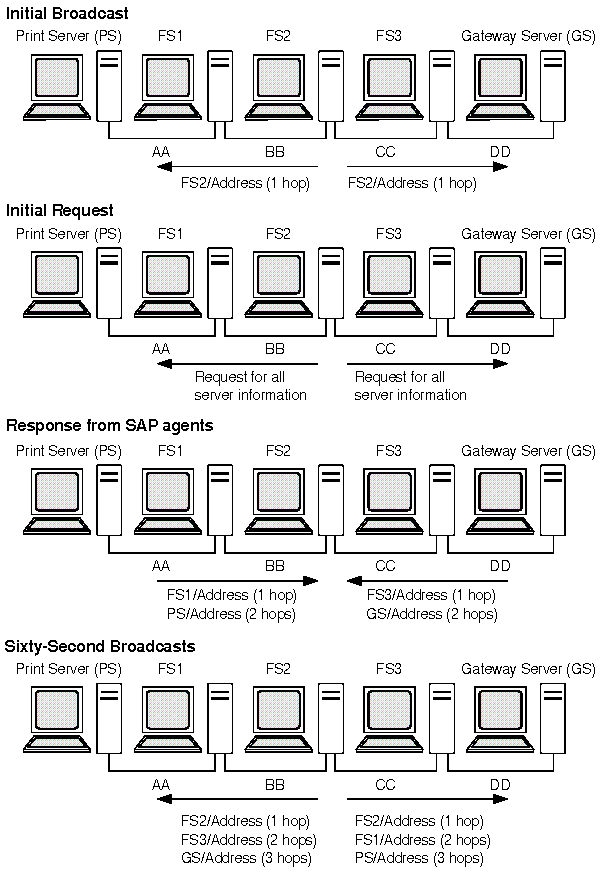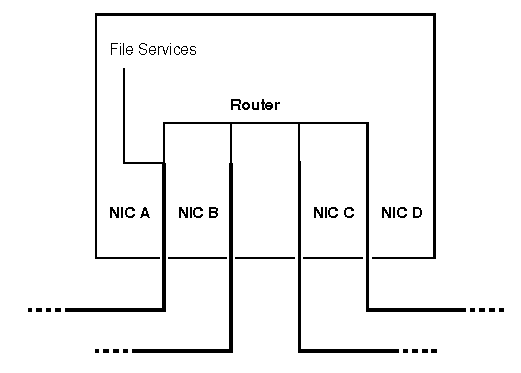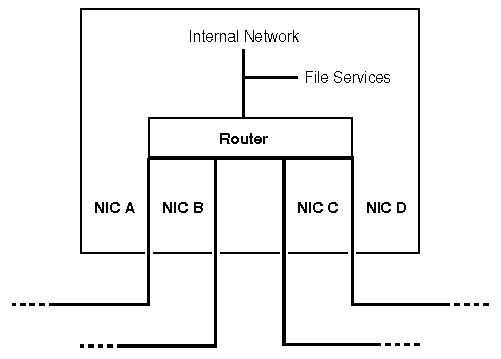
|
|
Servers on a NetWare network advertise their services and IPX addresses with the Service Advertising Protocol (SAP). The information that these servers broadcast is not used directly by clients but, instead, is collected by a SAP agent within each NetWare router on the server's segment. The SAP agents store this information in a Server information table and, if they reside within a server, in their server's bindery. The clients can then contact the nearest SAP agent or file server for server information.
The SAP broadcasts that servers perform are local broadcasts and, therefore, only received by SAP agents on their connected segments. Consequently, SAP agents periodically broadcast their server information so that all SAP agents on the network have information about all servers that are active on the network -- this is the same broadcast method used by routers to distribute and exchange network number (RIP) information.
The table that SAP agents use to store information received in SAP broadcasts is called the server information table. If all SAP agents on the network are exchanging SAP information properly, each agent's server information table should have information about all the servers on the network, thus providing clients with nearby access to the IPX addresses of all the servers on the network.
The server information table contains the following fields:
Services on a network are identified using Novell object types. ``Novell object types'' lists some of the Novell common object types.
Novell object types
| Description | Object type (hexadecimal) |
|---|---|
| User | 1 |
| User group | 2 |
| Print queue | 3 |
| File server | 4 |
| Job server | 5 |
| Gateway | 6 |
| Print server | 7 |
| Archive queue | 8 |
| Archive server | 9 |
| Job queue | A |
| Administration | B |
| NAS SNA gateway | 21 |
| NACS | 23 |
| Remote bridge server | 24 |
| Bridge server | 26 |
| TCP/IP gateway | 27 |
| Gateway | 29 |
| Time synchronization server | 2D |
| Archive server SAP | 2E |
| Advertising print server | 47 |
| BTrieve VAP 5.0 | 48 |
| SQL VAP | 4C |
| Xtree network version | 4D |
| BTrieve VAP 4.11 | 50 |
| Print queue user | 53 |
| WANcopy utility | 72 |
| TES - NetWare for VMS | 7A |
| NetWare access server | 98 |
| NVT server | 9E |
| NetWare 386 | 107 |
| Communications executive | 130 |
| NNS domain | 133 |
| NetWare 386 print queue | 137 |
| Wildcard | FFFF |
When a file server or, in the case of SCO IPX/SPX, SAPD is first brought up, its internal SAP agent:

Sequence used to build and maintain the server information table
As with routing information broadcasts, all server information broadcasts are local broadcasts and are subject to the best information algorithm. Any changes in server information are passed on immediately to ensure current information across the network. The router applies the aging process to its server information table entries in case any servers become unavailable. Finally, if the router is brought down, it will indicate to its directly connected segments that the servers the router has been advertising will no longer be available.
Value-added servers, such as database and print servers, normally contain only one network adapter and use the address of that adapter as the address they advertise in their periodic SAP broadcasts. In contrast, NetWare file servers may contain multiple adapters. This requires that they use some sort of convention for advertising the address of their file services; the convention used for this addressing differs for 286- and 386-based servers.
Within the 286-based environment, the services of a file server are addressed with respect to its first NIC, A. This convention guarantees consistency because every server will have at least one network adapter installed. ``Addressing of file services on a 286-based NetWare file server'' illustrates this convention.

Addressing of file services on a 286-based NetWare file server
In the NetWare 386-based servers, an internal network has been
added for the addressing of internal services, as shown in
``Addressing of file services on a 386-based NetWare file server''.
This different method of addressing requires that an internal
network number be assigned when a NetWare 386-based file server
is brought up.
SCO IPX/SPX requires an internal network number.

Addressing of file services on a 386-based NetWare file server
NetWare 386-based servers can be distinguished by a node number of one. This node number is assigned to the file services on the internal network number.